This article was published in Scientific American’s former blog network and reflects the views of the author, not necessarily those of Scientific American
I’ve long planned to cover grebes here at Tet Zoo. Today we’ll look briefly at this fascinating group before focusing in particular on the fact that grebes of several species are not doing at all well, and that more needs to be done about their plight. [Image above shows high-walking Western grebe Aechmophorus occidentalis by Darren Naish, displaying Great crested grebe Podiceps cristatus by Steve Garvie, CC BY-SA 2.0.]
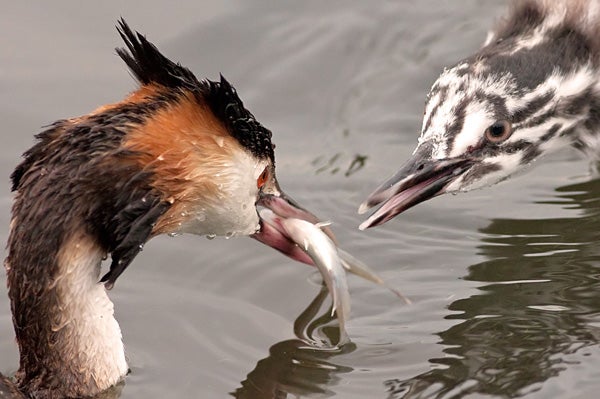
Great crested grebe about to feed juvenile. Photo by Mark Medcalf, CC BY 2.0.
Just over 20 grebe species inhabit the world today. The group is technically known as the Podicipediformes, though there’s a long history of this name being spelt in various alternative ways and the name Colymbiformes was used for the group in the past. Grebes occur on all continents, at all latitudes from the tropics to the edges of the polar regions, and range in size from 120 g and 24 cm (in the Least grebe Tachybaptus dominicus) to 1.7 kg and 70 cm (in the Great grebe Podiceps major).
On supporting science journalism
If you're enjoying this article, consider supporting our award-winning journalism by subscribing. By purchasing a subscription you are helping to ensure the future of impactful stories about the discoveries and ideas shaping our world today.
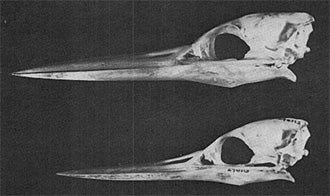
The long, dagger-like bill of the Western grebe (image from Selander 1966). This photo shows the obvious sexual dimorphism in proportional bill length present in this species (male above, female below).
Neck length and bill length are variable within the group, smaller species tending to be shorter-necked and shorter-billed and with a generalised diet that involves invertebrates, fish and small amphibians. Some of the larger species are spear-billed and are more specialised for fish-catching. A peculiarity of the group concerns deliberate ingestion of their own feathers, something which means that feathers can take up as much as 50% (by weight) of their stomach contents. Quite why they do this is still not fully determined, the most common suggestion being that the swallowed feathers held protect the stomach lining from fish bones. This seems odd in view of the fact that there are plenty of other fish-eating birds that don’t use the same trick.
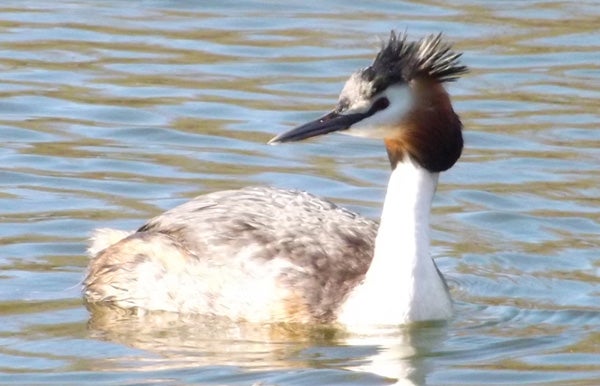
Great crested grebe: one of a pair engaged in a ritualised mating display, photographed in the UK by Darren Naish.
Grebes are remarkable birds for lots of other reasons. They lack rectrices (the feathers that normally form a tail-fan) and there are many species where both males and females are resplendent and ornamented. Indeed, grebes are the first group of animals in which the phenomenon of mutual sexual selection was recognised (Huxley 1914), a topic covered several times on Tet Zoo before (see links below).
Grebes are reliant on their massively muscled hindlimbs and enormous lobed feet in swimming and diving, the lobes flaring out when the toes are spread but folding into a blade during the recovery stroke. It was long thought that their swimming style relied entirely on the thrust produced as these large, lobed toes are swept backwards. However, the feet are actually pushed mostly sideways during the power stroke, a circular motion occurring at the same time, and it seems that the lobes produce lift, not thrust alone. The feet thus function as propellers or multi-slotted hydrofoils (Johansson & Norberg 2001).
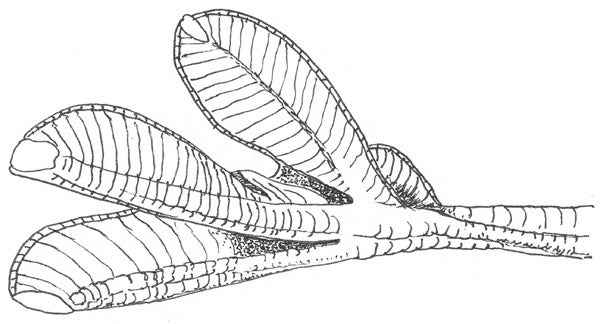
Foot of a grebe in anterior view. Image from Naish (2012).
Incidentally, I have to mention the fact that I once watched a one-legged Great crested grebe Podiceps cristatus pursuing a fish (a small trout), and exhibiting a speed and level of agility that looked normal for its species (I was on a bridge, looking down at the animals below the water). Alas, no photos.
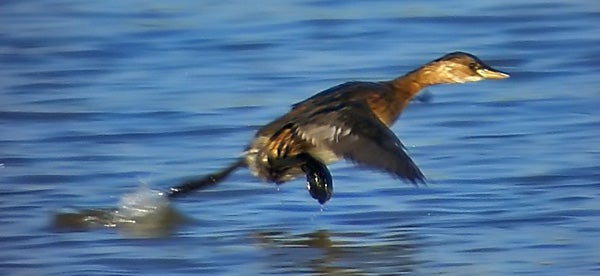
Are grebes really "poor fliers"? Here's a Little grebe during takeoff. Image by Ferran Pestaña, CC-BY-SA-2-0.
Misconceptions you may hold about grebes. Because grebes are so well adapted for swimming, and because their flight appears so direct and ‘heavy’, a common assumption has been that they’re “poor fliers”, the implication being that they’re somehow destined for flightlessness and are only flying because they haven’t yet completed the process of losing their ancestral flight ability. There’s no denying that some grebe lineages are, indeed, evolving towards a flightless condition (or have reached it already), but this notion of grebes as “poor fliers” is erroneous, as it often is when said of birds with high wing-loading and rapid, direct, ‘heavy’ flight. I rather like Gary Kaiser’s description of grebes and similarly shaped birds as being like jet transporters: heavy, needing lots of fuel to get airborne and stay aloft, but fast, and able to both carry extra weight and cover great distance (Kaiser 2007). Indeed, grebes are not “poor fliers” at all: consider that several species are often recorded as trans-oceanic vagrants.
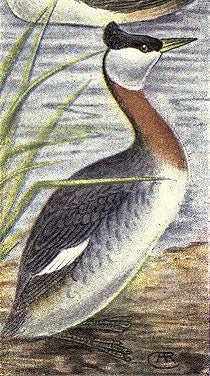
Old illustrations (and taxiderm mounts) often grebes standing upright, like this. But this is impossible, right? Illustration by Chester Reed, in public domain.
Oh – one more thing on locomotion: the far posterior location of the hindlimbs has led to a (not unreasonable) belief that grebes can’t stand or walk on land, the idea being that they have to push themselves along on their fronts when out of water. Mounted 19th century taxidermy specimens – so often posed bolt upright, the chest well off the ground – have been deemed ‘wrong’ by people who are experts on birds and anatomy (mentioning no names). If you know your birds, you’ll know that this sort of thing hasn’t been said of grebes alone, but of divers (= loons) as well, and also of the Cretaceous hesperornithines. I said it myself of the weird Musk duck Biziura lobata in a Tet Zoo article of 2010, and boy do I regret it now.
You see, grebes and Musk ducks (and divers? And hesperornithines?) actually can walk on land, and can even elevate the body and walk and run erect with the body well off the ground (the stills shown here are taken from this video). Alas, this does seem to be extremely costly and tiring, and they can’t keep it up for long. Nevertheless, it means that another assumption we’ve long made about grebes is not really accurate.
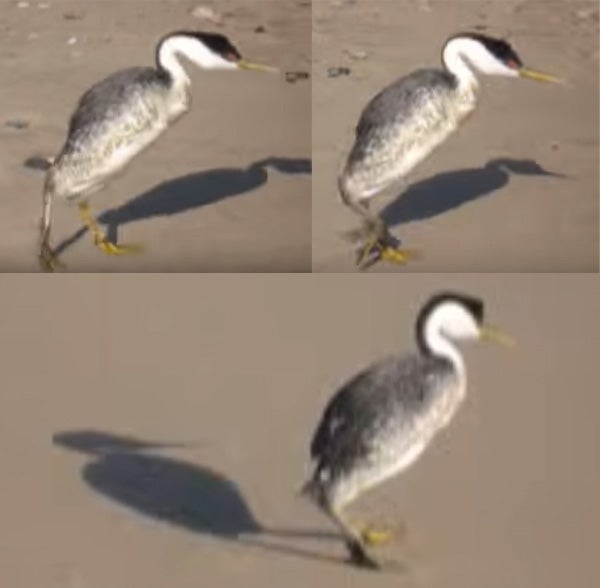
Screengrabs from a film that shows a high-walking, running grebe. I love the shadow in the image at bottom.
The plight of grebes. For all their anatomical and behavioural novelty, the main thing that ornithologists discuss about grebes today is their plight. Sadly, grebes of several species are in trouble, and in cases are either in critical decline, or are in suspected decline and in urgent need of both conservation and of research on their ecology and habitat. A combination of factors – the introduction of sport fish that have disrupted native ecosystems, the use of gillnets, hydroelectric schemes, habitat loss and degradation, and hybridisation with related species – have all contributed to grebe decline and extinction, and at least some of these factors are still creating problems, or – sad to say – are creating more problems than ever before.
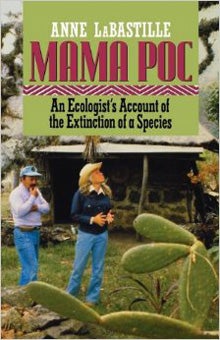
Cover of LaBastille (1990), required reading for grebe fans. Anne LaBastille died in 2011. She is perhaps most famous for her Woodswoman books.
The best known case involves the Giant pied-billed grebe or Atitlan grebe Podilymbus gigas of Guatemala’s Lake Atitlan, a large, flightless grebe that became extinct round about 1990. Its story has been told in many books and is quite famous (the account given here is mostly based on what Errol Fuller says in his 2000 Extinct Birds), as is the remarkable ecologist and conservationist who devoted so much time and effort to save it (the late great Anne LaBastille). It first became obvious that P. gigas was in decline during the 1960s when large-mouthed bass – introduced (by Pan-Am) to boost use of the lake as a fishing resort – were noted as having a deleterious impact on the lake’s ecology. Reed beds at the edge of the lake were being removed at the time, and water drained from the lake during the 1970s (needed for earthquake relief) damaged the lake further (Mulvaney 1988, LaBastille 1990, Fuller 2000).
This ecological modification apparently improved conditions for a species that now moved in from elsewhere, the widespread and flight-capable Pied-billed grebe P. podiceps. Despite being morphologically and ecologically quite distinct, the two species could interbreed, and it appears that dilution of the last Atitlan grebes with Pied-billed grebe genes further contributed to the species’ disappearance.
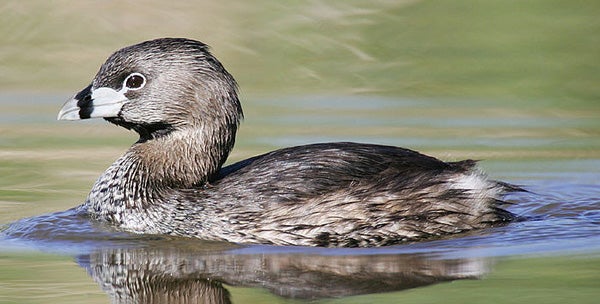
Pied-billed grebe Podilymbus podiceps photographed in Arizona (USA), image by Mdf, CC-BY-SA 3.0.
This latter factor means that P. gigas may not be completely extinct, since its genes presumably lurk within the Guatemalan Pied-billed grebe population. Just what we might ever do about that, however, is a subject for speculation: it’s fun to talk about de-extinction and so on, but the fact is that no-one is going to come forward and find or provide the funding needed for any resurrection project. Or, go on… prove me wrong.
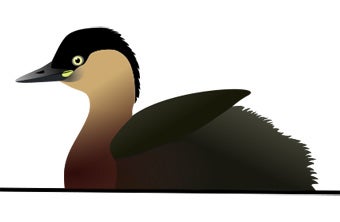
Illustration of the flightless Madagascan grebe Tachybaptus rufolavatus by L. Shyamal, CC BY-SA 3.0. There is a single known photo of this species and it isn't available for use.
Depressingly similar stories can be told about some other grebe species. The Colombian grebe Podiceps andinus died out in or close to 1977 after a few decades of decline brought about by pollution, drainage of its habitat, and predation on its chicks by introduced Rainbow trout Oncorhynchus mykiss. The Rusty grebe, Delacour’s little grebe or Alaotra grebe Tachybaptus rufolavatus of Madagascar was declared extinct in 2010, its decline also being caused by human intervention (the use of gillnets and habitat degradation). It was another flightless species.

Classic illustration of Junín grebe by J. G. Keulemans. Image in public domain.
The last flightless grebes. For a group that contains just 25 or so Holocene species, the loss of three of them – during the most technologically adept and conservation-minded phase of our species’ entire history – is appalling. Clearly, grebes are massively disadvantaged by the sort of things we do to the lakes where they occur. But what’s also clear is that we do all too little to reverse the trends when things go wrong.
It’s for these reasons that Gunnar Engblom has recently sent up a crowd-funded project to investigate the decline of a grebe that isn’t yet extinct, but is certainly at risk of becoming so if things don’t improve. The species is the Junín grebe or Puna grebe Podiceps taczanowskii of Peru, a flightless species with a population that has crashed from about 1000 in the 1960s to 300 or less today. Pollution resulting from nearby mining activity and the impact of a nearby hydroelectric scheme are thought to have contributed to this decline (Valqui 1994), and attempts to relocate the grebes to nearby lakes have failed due to gillnets.
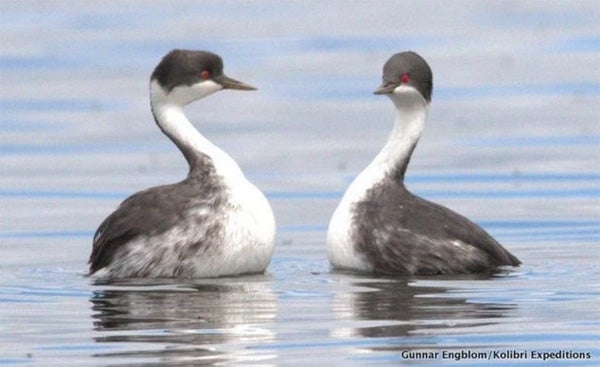
Junín grebe pair, photo by Gunnar Engblom/Kolibri Expeditions.
What with the loss of the Atitlan grebe and Alaotra grebe, this is one of only two remaining flightless grebes (the other is the Titicaca grebe Rollandia microptera of Peru and Bolivia). What’s notable is that comparatively little assessment and research of the Junín grebe’s status has been performed; improved monitoring and investigation are urgently required. I therefore invite you to chip in to this most worthy cause. It’s hoped that research will highlight the sort of conservation efforts that are needed to make a difference, and that we might be able to do something that will help. You’ve seen how amazing and peculiar grebes are – let’s help keep them this way.
For previous Tet Zoo articles relevant to some of the subjects mentioned here, see...
Getting a major chapter on birds ALL birds into a major book on dinosaurs
Did dinosaurs and pterosaurs practise mutual sexual selection?
Refs - -
Fuller, E. 2000. Extinct Birds. Oxford University Press, Oxford.
Huxley, J. 1914. The courtship habits of the Great Crested Grebe (Podiceps cristatus); with an addition to the theory of sexual selection.Proceedings of the Zoological Society ofLondon 35, 491-562.
Johansson, L. C. & Norberg, U. M. L. 2001. Lift-based paddling in diving grebe. The Journal of Experimental Biology 204, 1687-1696.
Mulvaney, K. 1988. When extinction is almost merciful. BBC Wildlife 6 (6), 272-273.
Selander, R. K. 1966. Sexual dimorphism and differential niche utilization in birds. Condor 68, 113-151.
Valqui, T. 1994. The extinction of the Junín flightless grebe? Cotinga: 42-44.